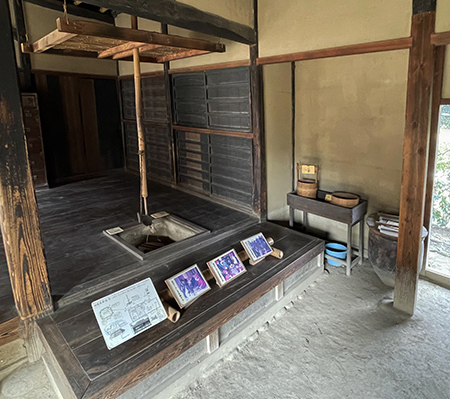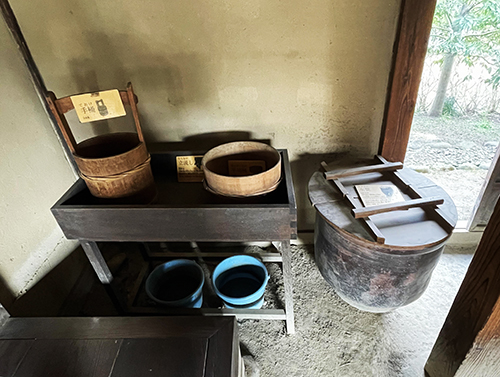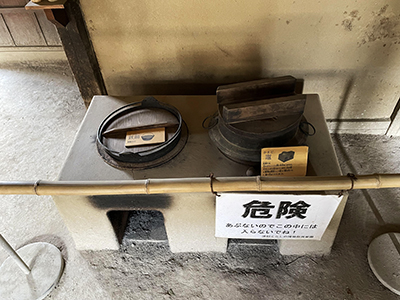


浦和の開発農家・蓮見家の台所空間。
土間に隣接して囲炉裏が板の間にあってそのすぐ近くに「流し」がある。土間と裏口をはさんでカマドが対置されている。現代の間取りでいえばシステムキッチンとダイニングの空間に相当している。というか、およそ300年前の調理空間だけれど、現代と通底する面が非常に多いと思う。
流しでの作業では水瓶から取水しながら食材を洗い包丁で裁断しながら、一方で加熱調理火力は基本的にはカマドでメイン食材を調理し、補助的に囲炉裏火力も利用したのだろう。それらの動線がたいへん合理的な間取りで構成されていることが一目瞭然。
これより古い時代の戦国期の調理の場の復元などを見る機会があったけれど、そこでは流しが「座った」姿勢で作業するスタイルが取られていた。広い板敷き空間でたくさんの女性たちがほぼ座った体制で、調理作業に向き合うというのがより原初的であるのかと思わされたけれど、この江戸中期の時代・関東の農家住宅では「立って」食材と向き合うスタイルになっている。時代の進化だろうか。作業効率的にどう考えても、座ったままの状態では力仕事的な調理作業などにはあまり合理的とは言えないだろう。まぁ一方でその分、盛り付け作業などの繊細な部分についてはこの座作業で日本的気遣い文化が盛り上がった可能性がある。
日本の家庭料理文化にこのポイントがどのように影響を与えたのか,興味深い。
台所の作業空間にはその時代での女性を中心としたライフスタイルが顕著に反映していると思う。最近の家事と間取りの関係を見ると、夫婦共働きを前提にして、洗濯と乾燥、衣類の整理作業が非常に合理的に、時間節約的になっていてファミリークローゼットが主役化してきている。台所は食卓と一体化してより作業効率的な合理化が進展していると思います。
この江戸期農家住宅でも基本的に女性は「共働き」が前提でしょう。室内空間のおよそ半分を占める土間空間は基本的に農作業のための主要装置であり、生業である農業の核心作業空間。早朝からの屋外作業のための準備から夜なべ仕事としての「縄」などの植物繊維加工作業まで、朝から夕方、夜まで基本的には農作業が延々と続く毎日。これら土間での農事作業との時間節約型での「連続性」が大きな「解決課題」だった様子がわかる。当然日々の農事に関連した食材が食卓に上っただろうから、一体化は必然でもあった。
まぁ、現代では食の空間以上に洗濯乾燥仕舞などの作業も肥大化してきているので、まことに「世に連れて」家事作業の解決方法は変化してきていると思う。
いずれにしてもこうした先人の生活痕跡には深くリスペクトさせられる。
English version⬇
300-year-old cooking and boiling space Urawa development farmer-4
How did the rational change of “sink” from sedentary to standing work affect the Japanese lifestyle? …
Kitchen space of the Hasumi family, a development farmhouse in Urawa.
Adjacent to the earthen floor is a sunken hearth on a wooden floor with a “sink” in the immediate vicinity. A kamado is placed across the earthen floor and the back door. In a modern layout, this space would correspond to a system kitchen and dining room. Although the cooking space is about 300 years old, it has many similarities with the modern kitchen.
In the sink, food was washed and cut with a knife while water was drawn from a water bottle, while the main food was basically cooked in a kamado and hearth heat was used as an auxiliary heat source. It is obvious at a glance that these lines of flow are composed of a very rational floor plan.
I had an opportunity to see a reconstruction of a cooking area from the Warring States period, which was much older than this, where the sink was used in a “sitting” position. I thought it was more primitive to have a large number of women sitting down in a large wooden floor to face the cooking work, but in this farmhouse in the Kanto region during the mid-Edo period, they are “standing” to face the foodstuffs. Is this an evolution of the times? In terms of work efficiency, sitting down is not very reasonable for heavy-duty cooking. On the other hand, the Japanese culture of care and attention to detail in such delicate tasks as serving may have been enhanced through the use of this sitting style of cooking.
It is interesting to see how this point influenced the Japanese home cooking culture.
I think that the kitchen workspace reflects the lifestyle of the time, especially that of women. Looking at the relationship between housework and the floor plan these days, based on the assumption that both husband and wife work, washing and drying and organizing clothes have become very rational and time-saving tasks, and the family closet has taken on a leading role. The kitchen is integrated with the dining table, and I believe that more efficient rationalization of work has progressed.
Even in this Edo period farmhouse, women are basically supposed to “work together”. The earthen floor space, which occupies about half of the interior space, is basically the main equipment for farm work, and is the core work space for farming, which is the livelihood of the farmers. From early morning preparation for outdoor work to nighttime work processing plant fibers such as “rope,” farm work basically goes on and on from morning to evening and into the night. It is clear that time-saving “continuity” with the farm work in the earthen floor was a major “problem to be solved. Naturally, food related to the daily farm work would have appeared on the dining table, so the integration of the two was inevitable.
Well, nowadays, washing, drying, and putting away clothes has become even bigger than the space for food, so I think that the solution to housework has changed “with the times.
In any case, I deeply respect the traces of our ancestors’ lives.
Posted on 7月 22nd, 2023 by 三木 奎吾
Filed under: 住宅マーケティング, 日本社会・文化研究







コメントを投稿
「※誹謗中傷や、悪意のある書き込み、営利目的などのコメントを防ぐために、投稿された全てのコメントは一時的に保留されますのでご了承ください。」
You must be logged in to post a comment.